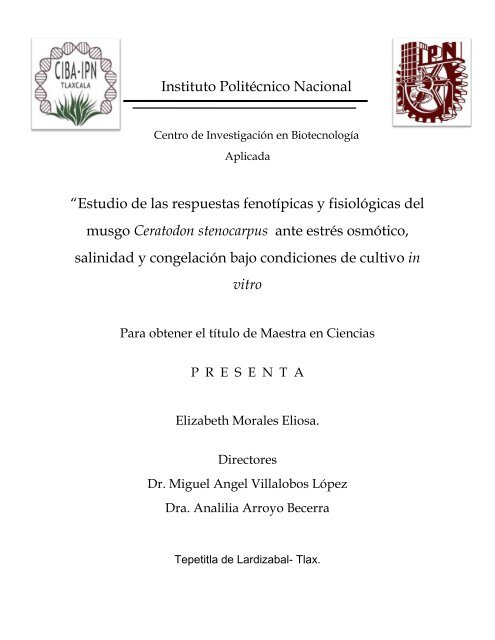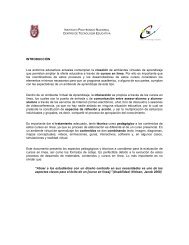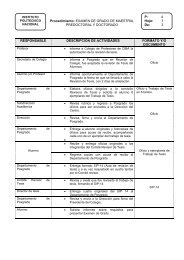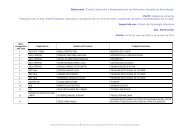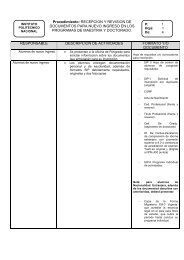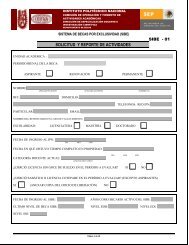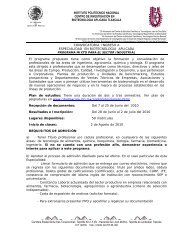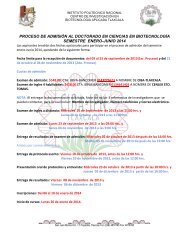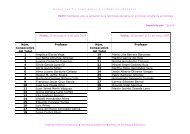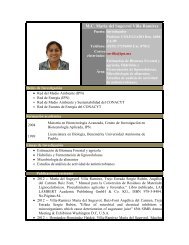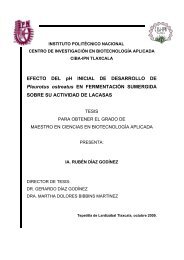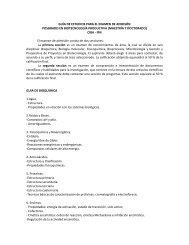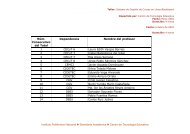Estudio de las respuestas fenotÃpicas y fisiológicas del musgo ...
Estudio de las respuestas fenotÃpicas y fisiológicas del musgo ...
Estudio de las respuestas fenotÃpicas y fisiológicas del musgo ...
Create successful ePaper yourself
Turn your PDF publications into a flip-book with our unique Google optimized e-Paper software.
Instituto Politécnico Nacional<br />
Centro <strong>de</strong> Investigación en Biotecnología<br />
Aplicada<br />
“<strong>Estudio</strong> <strong>de</strong> <strong>las</strong> <strong>respuestas</strong> fenotípicas y fisiológicas <strong>de</strong>l<br />
<strong>musgo</strong> Ceratodon stenocarpus ante estrés osmótico,<br />
salinidad y congelación bajo condiciones <strong>de</strong> cultivo in<br />
vitro<br />
Para obtener el título <strong>de</strong> Maestra en Ciencias<br />
P R E S E N T A<br />
Elizabeth Morales Eliosa.<br />
Directores<br />
Dr. Miguel Angel Villalobos López<br />
Dra. Analilia Arroyo Becerra<br />
Tepetitla <strong>de</strong> Lardizabal- Tlax.
Resumen<br />
El crecimiento <strong>de</strong> <strong>las</strong> plantas y su productividad se ven afectados por los<br />
diversos factores <strong>de</strong> estrés abiótico. El déficit <strong>de</strong> agua es uno <strong>de</strong> los principales<br />
factores abióticos <strong>de</strong>sfavorables afectado el crecimiento y rendimiento <strong>de</strong> los<br />
cultivos agríco<strong>las</strong>. En general, la sequía se produce cuando el agua disponible en<br />
el suelo se reduce y <strong>las</strong> condiciones atmosféricas causan pérdida continua <strong>de</strong><br />
agua por la transpiración o evaporación. En la naturaleza existen plantas que han<br />
<strong>de</strong>sarrollado estrategias <strong>de</strong> tolerancia al déficit hídrico como son <strong>las</strong> briofitas son<br />
entre <strong>las</strong> primeras plantas que dominaron la vida terrestre <strong>de</strong>s<strong>de</strong> más <strong>de</strong> 400<br />
millones <strong>de</strong> años, y ahora son distribuidas en todo el mundo <strong>de</strong>s<strong>de</strong> los trópicos<br />
hasta la Antártida (Proctor and Tuba 2002; Robinson et al. 2003). Su adaptación a<br />
la tierra se atribuye a la resistencia al estrés por <strong>de</strong>secación que causa una rápida<br />
<strong>de</strong>shidratación <strong>de</strong> <strong>las</strong> célu<strong>las</strong> (Oliver et al. 2000).<br />
En este trabajo se realizaron estudios fenotípicos y fisiológicos en el <strong>musgo</strong><br />
Ceratodon stenocarpus el cual no ha sido i<strong>de</strong>ntificado, a<strong>de</strong>más ya se cuenta con el<br />
sistema <strong>de</strong> cultivo in vitro. Se realizaron ensayos en célu<strong>las</strong> <strong>de</strong> protonema<br />
obtenidas a través <strong>de</strong> la germinación <strong>de</strong> mezcla <strong>de</strong> esporas que expuestas<br />
durante 25 días a concentraciones <strong>de</strong> agentes osmóticos (Sorbitol y Manitol <strong>de</strong><br />
400 hasta 1000 mM y NaCl <strong>de</strong> 200 hasta 500 mM). El tejido protonemal <strong>de</strong>l <strong>musgo</strong><br />
resultaron ser tolerante a estrés osmótico en concentraciones <strong>de</strong> 400 a 800 mM,<br />
a<strong>de</strong>más dichos tejidos presentaron la capacidad <strong>de</strong> recuperar su metabolismo<br />
normal, <strong>de</strong>spués <strong>de</strong> 85 días en medio control.<br />
Los ensayos realizados con célu<strong>las</strong> <strong>de</strong> protonema sometidas a estrés salino<br />
durante 25 días, estas presentaron tolerancia en concentraciones <strong>de</strong> 200 hasta<br />
500 mM, <strong>de</strong> igual forma presentaron la capacidad <strong>de</strong> recuperar su pigmentación al<br />
ser transferidas a medio control en un tiempo <strong>de</strong> 19 días.<br />
Por otra parte se evaluó la participación <strong>de</strong>l acido abscisico (ABA) en <strong>las</strong><br />
célu<strong>las</strong> <strong>de</strong> protonema expuestas a altas concentraciones <strong>de</strong>l agente osmótico<br />
(Sorbitol <strong>de</strong> 800 hasta 2000 mM) durante diez días, resultando fenotipos <strong>de</strong><br />
tolerancia en todas <strong>las</strong> concentraciones. A<strong>de</strong>más el <strong>musgo</strong> tuvo la capacidad <strong>de</strong>
ecuperar su metabolismo normal en un tiempo <strong>de</strong> 35 días, al transferir <strong>las</strong> célu<strong>las</strong><br />
<strong>de</strong> protonema a medio control. Así también la participación <strong>de</strong> ABA en el <strong>musgo</strong> C.<br />
stenocarpus para conten<strong>de</strong>r con el estrés salino fue contun<strong>de</strong>nte para tolerar<br />
concentraciones <strong>de</strong> 400 a 800 mM al ser expuesto en dichas concentraciones<br />
durante diez días.<br />
A<strong>de</strong>más nuestro mo<strong>de</strong>lo <strong>de</strong> estudio resulto ser tolerante a estrés por<br />
congelación al ser sometido a temperaturas <strong>de</strong> -10ºC, -20ºC y 76ºC durante siete<br />
días, con la participación <strong>de</strong> ABA.<br />
Al realizar los estudios fisiológicos a través <strong>de</strong> la medición <strong>de</strong> la actividad<br />
fotosintética <strong>de</strong>l PSII en <strong>las</strong> célu<strong>las</strong> <strong>de</strong> protonema sometidas en cada uno <strong>de</strong> los<br />
estreses abióticos, este mostro un comportamiento general <strong>de</strong> disminución<br />
durante el estrés abiótico, sin embargo este mostro recuperación <strong>de</strong> su actividad al<br />
transferir los tejidos a medio control.<br />
De acuerdo a nuestros estudios realizados en célu<strong>las</strong> <strong>de</strong> protonema <strong>de</strong>l<br />
<strong>musgo</strong> C. stenocarpus lo proponemos como un mo<strong>de</strong>lo <strong>de</strong> estudio en <strong>las</strong><br />
<strong>respuestas</strong> <strong>de</strong> tolerancia ante los estreses bióticos específicamente osmótico,<br />
salinidad y congelación.<br />
.
Abstract<br />
The plant growth and productivity are affected by various abiotic stress<br />
factors. The water <strong>de</strong>ficit is a major abiotic stresses affecting growth and yield of<br />
agricultural crops. In general, drought occurs when the available soil water is<br />
reduced and atmospheric conditions cause continuous loss of water through<br />
transpiration and evaporation. In nature there are plants that have <strong>de</strong>veloped<br />
strategies for tolerance to water <strong>de</strong>ficit such as bryophytes are among the first<br />
plants that dominated terrestrial life from more than 400 million years and are now<br />
distributed worldwi<strong>de</strong> from the tropics to Antarctica (Proctor and Tuba 2002;<br />
Robinson et al. 2003). Adaptation to the land is attributed to the resistance to<br />
<strong>de</strong>siccation stress causes rapid <strong>de</strong>hydration of the cells (Oliver et al. 2000).<br />
In this work phenotypic and physiological studies conducted in the moss<br />
Ceratodon stenocarpus which has not been i<strong>de</strong>ntified, in addition to the culture<br />
system in vitro. Were carried out in protonema cells obtained through germination<br />
of spores mixture exposed for 25 days at concentrations of osmotic agents (sorbitol<br />
and mannitol of 400-1000 mM NaCl and 200-500 mM). Protonemal moss tissue<br />
were to be tolerant to osmotic stress at concentrations of 400-800 mM, these<br />
tissues also showed the ability to recover their normal metabolism, after 85 days in<br />
control medium.<br />
For tests protonema cells un<strong>de</strong>r salt stress for 25 days, they showed<br />
tolerance at concentrations of 200-500 mM, the same way had the ability to regain<br />
pigmentation to be transferred to control medium in a time of 19 days.<br />
Moreover we evaluated the involvement of abscisic acid (ABA) in protonema<br />
cells exposed to high concentrations of osmotic agent (sorbitol 800-2000 mM) for<br />
ten days, resulting phenotypes of tolerance at all concentrations. Moss also had<br />
the ability to recover their normal metabolism in a time of 35 days, by transferring<br />
protonema cells to control medium.
Also the involvement of ABA in moss C. stenocarpus to contend with the<br />
stress was overwhelming to tolerate salt concentrations of 400-800 mM when<br />
exposed to these concentrations for ten days. Furthermore, our study mo<strong>de</strong>l<br />
proved to be tolerant to freezing stress when subjected to temperatures of -10 º C,<br />
-20 º C and 76 º C for seven days, with the participation of ABA.<br />
In carrying out physiological studies through the measurement of<br />
photosynthetic activity of PSII in the cells of protonema subject in each of abiotic<br />
stress, this behavior showed a general <strong>de</strong>cline during abiotic stress, but this<br />
showed recovery of their activity transferring the medium control tissues.<br />
According to our studies of the moss protonema cells of C. stenocarpus we<br />
propose as a mo<strong>de</strong>l to study the responses of tolerance to biotic stresses<br />
specifically osmotic, salinity and freezing.


